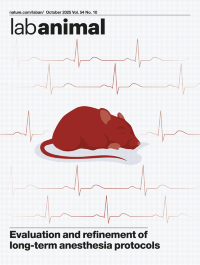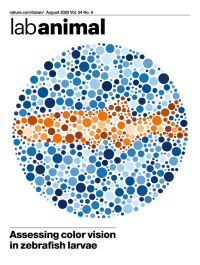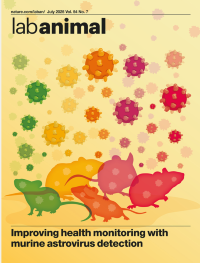Volume 54
-
No. 10 October 2025
Evaluation and refinement of long-term anesthesia protocolsAnesthesia is essential for minimizing the pain or distress experienced by laboratory animals during invasive procedures. However, anesthesia protocols have a wide range of physiological, neurological and immunological effects that may affect experimental outcomes. In a new Article, Virgilio et al. compared the effects of commonly used anesthetic protocols on mouse vital parameters and immunity. Compared to ketamine/xylazine, isoflurane showed superior safety and fewer effects on the immune system.
See Virgilio et al
-
No. 9 September 2025
Progressive meta-inflammation in obese pigsChronic low-grade inflammation, which is a common condition in obesity, has been associated with metabolic and cardiovascular dysfunction. In a new Article, Starbæk et al. show that Göttingen minipigs fed a high-fat, fructose and cholesterol diet develop meta-inflammation and endotoxemia. This study offers a valuable model for better understanding the link between obesity, meta-inflammation and cardiometabolic diseases.
See Starbæk et al
-
No. 8 August 2025
Assessing color vision in zebrafish larvaeZebrafish eyes are very similar in structure to human eyes. Like humans, zebrafish can also see a variety of color combinations, making them good candidates for color vision research. In a new Article, Eom et al. describe a color vision optomotor response assay for evaluating color vision deficiencies in zebrafish. This tool may prove useful for future zebrafish vision research.
See Eom et al
-
No. 7 July 2025
Improving health monitoring with murine astrovirus detectionMonitoring the health of laboratory mice is essential for standardizing experimental conditions. In a new article, Schmidt et al. examined the progression of murine astrovirus (MuAstV) infection and the associated immune response in three immunocompetent mouse strains and one immunodeficient strain. The results show that the immune response to MuAstV is strain-dependent, contributing to a better understanding of MuAstV infection characteristics. This study supports the inclusion of MuAstV in the routine health monitoring of laboratory mice.
See Schmidt et al.
-
No. 6 June 2025
Multi-site analysis of the zebrafish novel tank testAlthough the novel tank test is widely used to study anxiety-like responses in adult zebrafish, the optimal conditions for this assay have yet to be established. In a new Article, Hillman et al. performed a global multi-laboratory study to assess the effects of housing conditions and experimental settings on the novel tank test responses in zebrafish. The results suggest that standardizing protocols to account for sex differences, stocking densities and nutritionally rich feeds, while minimizing stressors, could improve the reliability and reproducibility of the test.
See Hillman et al.
-
No. 5 May 2025
Intranasal drug delivery in adult zebrafishDrug administration in zebrafish commonly happens through immersion. This method has many limitations, such as requiring larger drug quantities, and alternatives usually require restraining, which is stressful for the animals. In a new Article, Sander de Abreu et al. suggest that neuroactive drugs can be delivered to adult zebrafish intranasally, resulting in faster effects and smaller drug quantities when compared to administration through immersion.
See Sander de Abreu et al.
-
No. 4 April 2025
Myocardial infarction and the obesity paradoxAlthough obesity is a risk factor for the development of myocardial infarction (MI), several studies have suggested that patients with obesity have a survival advantage once MI has occurred. This ‘obesity paradox’ remains controversial and further studies are needed to understand the impact of obesity on MI outcomes. In a new Article, Flethøj et al. assessed the effects of obesity on echocardiographic findings, infarct size, circulating biomarkers, mitochondrial respiratory capacity and mortality in a minipig model of MI.
See Flethøj et al
-
No. 3 March 2025
Factors influencing wound healing in miceAlthough wound-healing assays are commonly used to study the complex processes underlying wound repair in mice, these experiments exhibit high variability. In a new Article, Yampolsky et al. show that the localization of the wound site and housing conditions can affect wound healing and the reproducibility of the assays.
See Yampolsky et al.
-
No. 2 February 2025
Exploring the effects of electrical stunning on zebrafish larvaeAvailable methods for zebrafish euthanasia have limitations. In a new Article, Burkhardt et al. investigated the behavioral and neurophysiological effects of electrical stunning on zebrafish larvae, showing that rapid and reliable euthanasia can be achieved with this method.
See Burkhardt et al.
-
No. 1 January 2025
Dietary effects across mouse life stagesDifferences in standard chow diets can influence mouse model phenotypes and impact experimental reproducibility. In a new Article, Knuth et al. measured the phenotypic effects of exposing mice to commonly used standard chows during different life stages. Their findings demonstrate that the timing of diet exposure can also affect phenotypic outcomes.
See Knuth et al.










